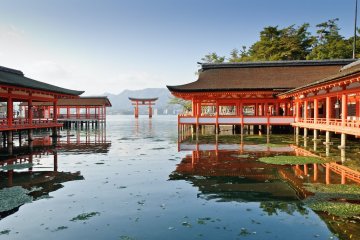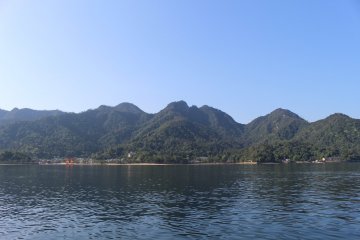
Парк Момидзидани в Миядзиме
Tomoko KamishimaПарк Момидзидани с его красивой осенней листвой находится в долине у подножия горы Мисэн на острове Миядзима.

Momijidani Park (紅葉谷公園, Momijidani-Kōen) is one of the most famous maple leaves valley parks in Japan. The park is located at the foot of Mt. Misen, along Momijidani River, behind Itsukushima Shrine in Miyajima, Hiroshima. [Wikipedia]
It's about a 20-minute walk south of Miyajima's pier area along a route that cuts through the Omotesando shotengai area.
It's also just a 2-minute walk from the Miyajima Ropeway at the base of Mount Misen.

Парк Момидзидани с его красивой осенней листвой находится в долине у подножия горы Мисэн на острове Миядзима.

The Itsukushima Shrine is located on the shores of Miyajima, an island in the Seto Inland Sea not far from Hiroshima city. While the name Itsukushima means “island of worship”, the site is more famously known as “the floating shrine”, as the buildings appear to be floating on the water when the tide rolls in. Itsukushima’s main shrine was first constructed in AD 593, and was mentioned in a famous Japanese book (Nihon Koki, or Notes on Japan) in AD 811. The shrine became popular as a pilgrimage destination for members of the Imperial Court during the Heian Period (745-1185) and remained an important location in the Edo Period for those living in western Japan. The main shrine precinct consists of a collection of buildings, such as the Purification Hall and the stage for bugaku (court music) performances. Many of the buildings are linked by covered corridors and dotted with bronze lanterns from the early 20th century. An arched bridge, dating back to 1557, was said to be used by Imperial messengers and is one of the links between the shrine and the mainland. Most notably, Itsukushima is home to a Noh stage that dates back to the early Edo Period, and is significant for the fact that it’s the only Noh stage in the country that floats upon the sea. Due to their history and unique design, the buildings of Itsukushima Shrine were designated as a National Treasure in 1952 and became a UNESCO World Heritage Site in 1996. Visitors who wish to see the shrine as it “floats upon the waves” would do best to plan their visit according to the tides. A schedule of the day’s high and low tides is usually posted at the shrine’s main entrance.

Daishō-in or Daisyō-in is a historic Japanese temple complex with many temples and statues on Mount Misen, the holy mountain on the island of Itsukushima, off the coast of Hatsukaichi, Hiroshima, Japan. It is the 14th temple in the Chūgoku 33 Kannon Pilgrimage and famous for the maple trees and their autumn colors. [Wikipedia]

Mount Misen (弥山) is a sacred mountain on the island of Miyajima (Itsukushima) in Hiroshima Prefecture. At 535 m, Mt Misen is the tallest mountain on the island.